


Start with a year value of 0, a column for the interest, and a balance of $10,000.
| year | interest | balance |
|---|---|---|
| 0 | $10,000 | |
Repeat the following steps while the balance is less than $20,000. Add 1 to the year value. Compute the interest as balance x 0.05 (i.e., 5 percent interest). Add the interest to the balance. Report the final year value as the answer.
Because the interest earned also earns interest, a bank balance grows exponentially.


while (condition)
{
statements
}
while (balance < targetBalance)
{
year++;
double interest = balance * RATE / 100;
balance = balance + interest;
}
Figure 1 Flowchart of a while Loop
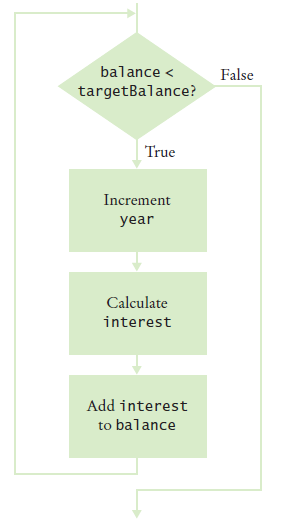

while (balance < targetBalance)
{
year++;
double interest = balance * RATE / 100;
balance = balance + interest;
}
// interest no longer declared here
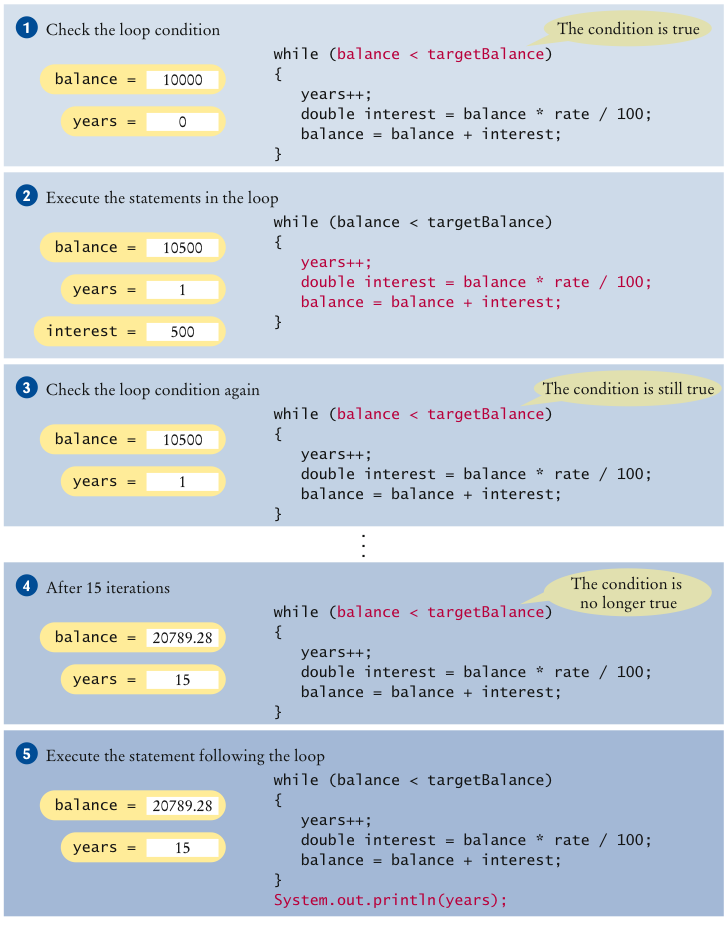
Figure 2 Execution of the Investment loop
The investment doubled after 15 years
Suppose we change the program so that the condition of the while loop is
while (balance <= targetBalance)
What is the effect on the program? Why?
int n = 1;
while (n < 100)
{
n = 2 * n;
System.out.print(n + " ");
}
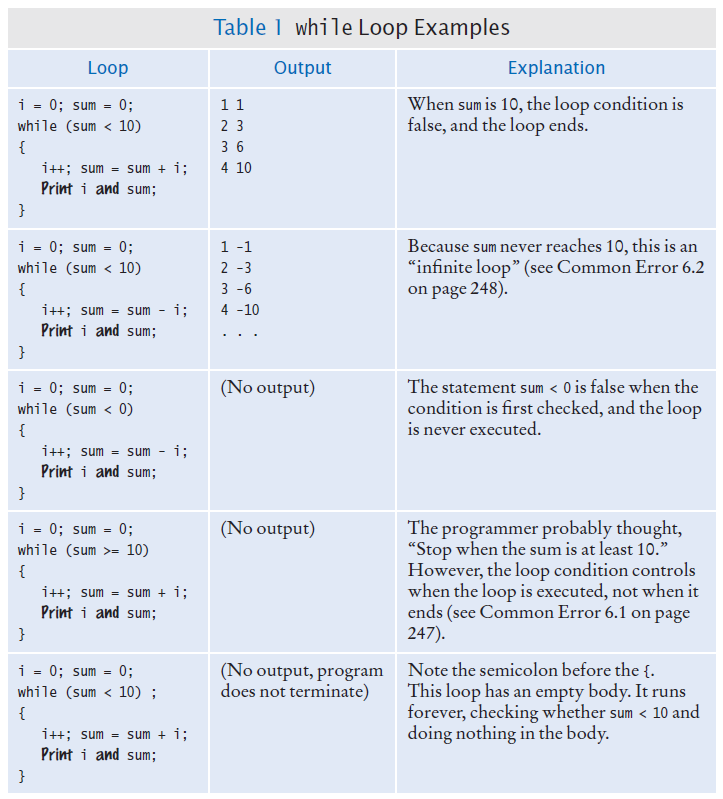
int years = 1;
while (years <= 20)
{
double interest = balance * RATE / 100;
balance = balance + interest;
}int years = 20;
while (years > 0)
{
double interest = balance * RATE / 100;
balance = balance + interest;
years++;
}
int years = 0;
while (balance < targetBalance)
{
years++;
balance = balance * (1 + RATE / 100);
}
System.out.println("The investment doubled after "
+ year + " years.");
int n = 1729;
int sum = 0;
while (n > 0)
{
int digit = n % 10;
sum = sum + digit;
n = n / 10;
}
System.out.println(sum);

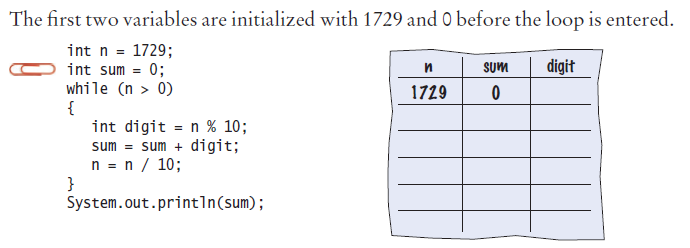

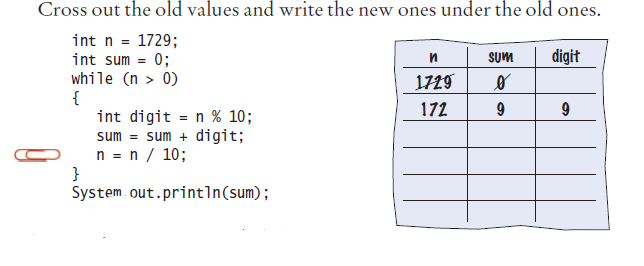
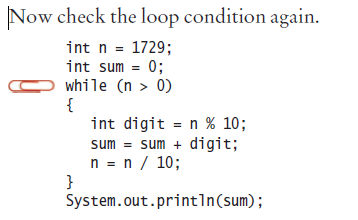

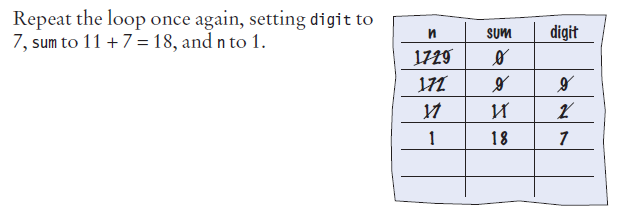
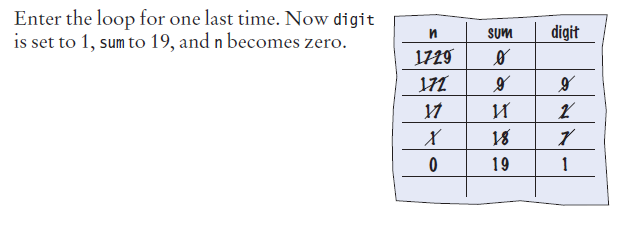
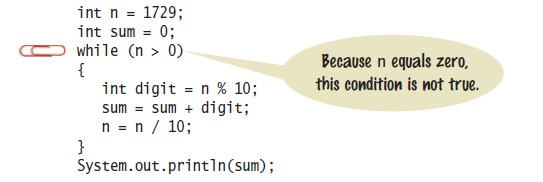
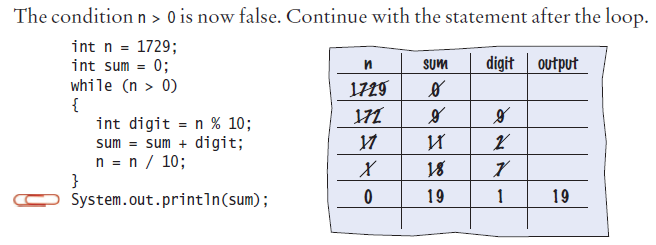
int n = 5;
while (n >= 0)
{
n--;
System.out.print(n);
}
n output54433221100 -1 -1
int n = 1;
while (n <= 3)
{
System.out.print(n + ", ");
n++;
}
n outputThere is a comma after the last value. Usually, commas are between values only.11,21, 2,31, 2, 3, 4
int r = 1;
int i = 1;
while (i <= n)
{
r = r * a;
i++;
}
a n r i 2 41122438416 5
int n = 1;
while (n != 50)
{
System.out.println(n);
n = n + 10;
}
n outputThis is an infinite loop. n is never equal to 50.11111121213131414151516161 ...
count = 1
temp = n
while (temp > 10)
Increment count.
Divide temp by 10.0.
Trace the pseudocode for n = 123 and n = 100. What error do you find?
count tempThis yields the correct answer. The number 123 has 3 digits.1123212.3 3 1.23
count tempThis yields the wrong answer. The number 100 also has 3 digits. The loop condition should have been while (temp >= 10).1100210.0
int counter = 1; // Initialize the counter
while (counter <= 10) // Check the counter
{
System.out.println(counter);
counter++; // Update the counter
}
for (int counter = 1; counter <= 10; counter++)
{
System.out.println(counter);
}

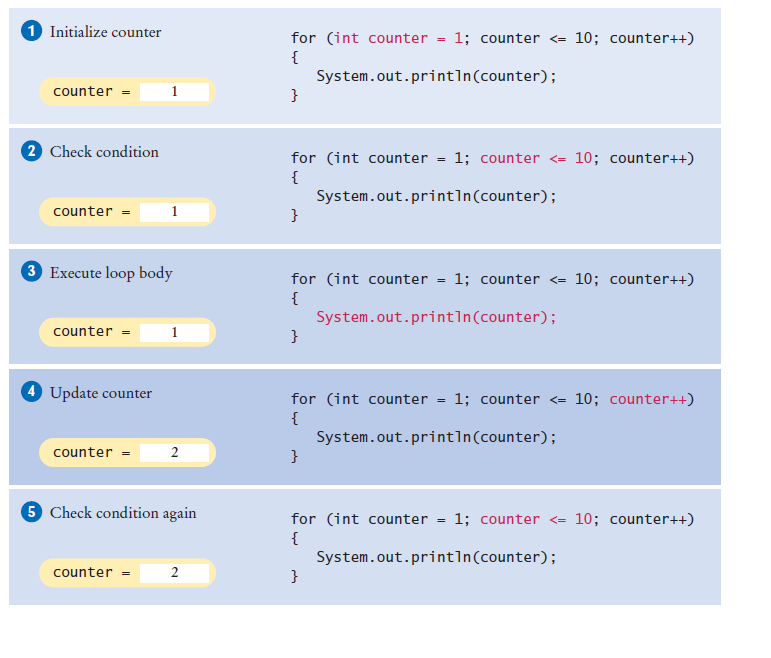
Figure 3 Execution of a for Loop
for (int counter = 10; counter >= 0; counter--) . . .
for (int counter = 0; counter <= 10; counter = counter + 2) . . .
for (int counter = 1; counter <= 10; counter++)
{
. . .
}
// counter no longer declared here
int counter;
for (counter = 1; counter <= 10; counter++)
{
. . .
}
// counter still declared here
for (int i = 0; i < str.length(); i++)
{
char ch = str.charAt(i);
Process ch.
}
for (int year = 1; year <= numberOfYears; year++)
{
Update balance.
}
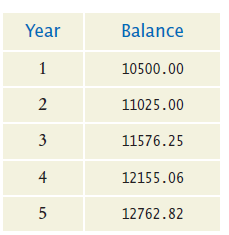
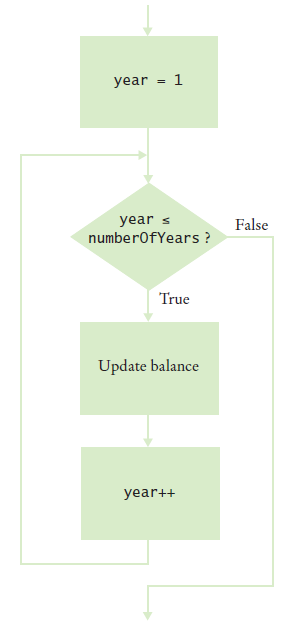
The balance after 20 years is 26532.98
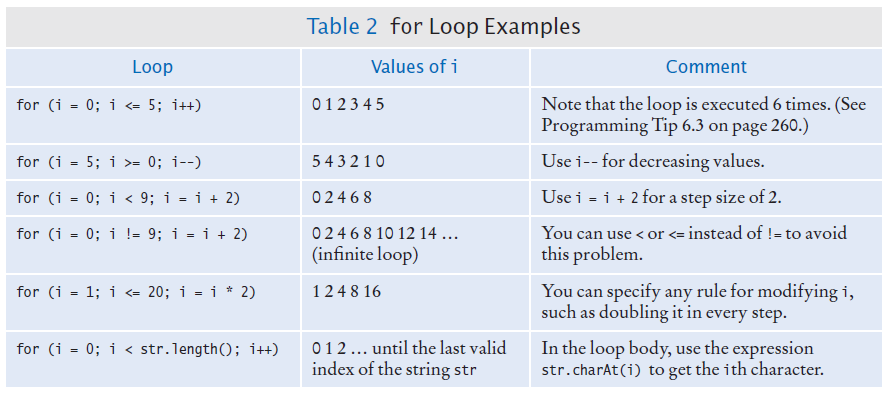
int years = 1;
while (years <= numberOfYears)
{
double interest = balance * rate / 100;
balance = balance + interest;
years++;
}
for (int n = 10; n >= 0; n--)
{
System.out.println(n);
}
Write a for loop that prints all even numbers between 10 and 20 (inclusive).
for (int i = 10; i <= 20; i = i + 2)
{
System.out.println(i);
}
int sum = 0;
for (int i = 1; i <= n; i++)
{
sum = sum + i;
}
final int PERIODS = 5;
for (int i = 1; i <= PERIODS; i++)
{
invest.waitYears(YEARS);
System.out.printf(
"The balance after %d years is %.2f\n",
invest.getYears(), invest.getBalance());
}
int value;
do
{
System.out.print("Enter an integer < 100: ");
value = in.nextInt();
}
while (value >= 100);
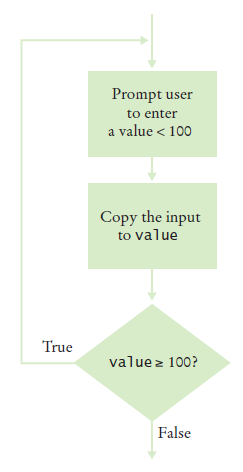
Suppose that we want to check for inputs that are at least 0 and at most 100. Modify the do loop for this check.
int value;
do
{
System.out.print("Enter an integer < 100: ");
value = in.nextInt();
}
while (value >= 100);
do
{
System.out.print(
"Enter a value between 0 and 100: ");
value = in.nextInt();
}
while (value < 0 || value > 100);
Rewrite the input check do loop using a while loop. What is the disadvantage of your solution?
int value;
do
{
System.out.print("Enter an integer < 100: ");
value = in.nextInt();
}
while (value >= 100);
int value = 100;
while (value >= 100)
{
System.out.print("Enter a value < 100: ");
value = in.nextInt();
}
Here, the variable value had to be initialized with an artificial value to ensure that the loop is entered at least once.
do { body } while (condition);
is equivalent to this while loop:
boolean first = true;
while (first || condition)
{
body;
first = false;
}int x;
int sum = 0;
do
{
x = in.nextInt();
sum = sum + x;
}
while (x != 0);int x = 0;
int previous;
do
{
previous = x;
x = in.nextInt();
sum = sum + x;
}
while (x != 0 && previous != x);
Enter salaries, -1 to finish: 10 10 40 -1 Average salary: 20
System.out.print("Enter salaries, -1 to finish: ");
boolean done = false;
while (!done)
{
value = in.nextDouble();
if (value == -1)
{
done = true;
}
else
{
Process value
}
}
System.out.print("Enter values, Q to quit: ");
while (in.hasNextDouble())
{
value = in.nextDouble();
Process value.
}
What does the SentinelDemo.java program print when the user immediately types -1 when prompted for a value?
Why does the SentinelDemo.java program have two checks of the form salary != -1
What would happen if the declaration of the salary variable in SentinelDemo.java was changed to
double salary = -1;
System.out.print("Enter values, Q to quit: ");
do
{
double value = in.nextDouble();
sum = sum + value;
count++;
}
while (in.hasNextDouble());
Sometimes termination condition of a loop can only be evaluated in the middle of the loop. There are different approaches:
boolean done = false;
while (!done)
{
String input = in.next();
if (input.equals("Q"))
{
done = true;
}
else
{
Process data.
}
}Additional approaches:
while (!(input = in.next()).equals("Q"))
{
Process data.
}
public void processInput(Scanner in)
{
while (true)
{
String input = in.next();
if (input.equals("Q"))
{
return;
}
Process data.
}
}

Storyboarding for a problem to convert units of measurement.
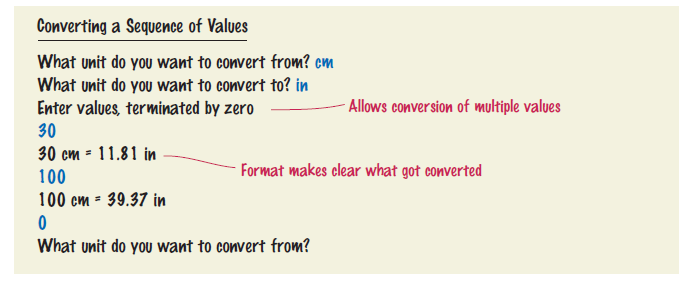

Storyboarding for a problem to convert units of measurement - part 2.

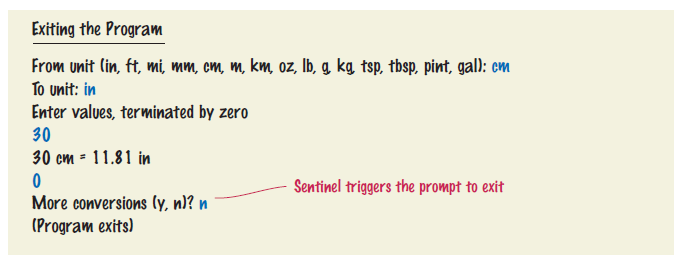
Provide a storyboard panel for a program that reads a number of test scores and prints the average score. The program only needs to process one set of scores. Don't worry about error handling.
Enter scores, Q to quit: 90 80 90 100 80 Q
The average is 88
(Program exits)
Google has a simple interface for converting units. You just type the question, and you get the answer.

Make storyboards for an equivalent interface in a Java program. Show a scenario in which all goes well, and show the handling of two kinds of errors.
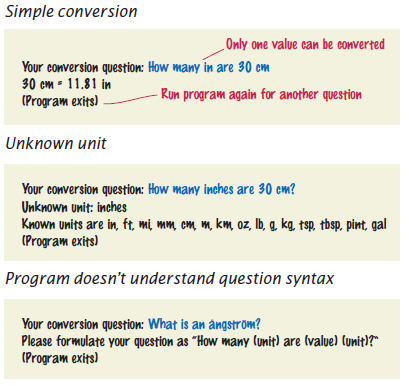
Consider a modification of the program in Self Check 26. Suppose we want to drop the lowest score before computing the average. Provide a storyboard for the situation in which a user only provides one score.
Enter scores, Q to quit: 90 Q
Error: At least two scores are required.
(Program exits)
What is the problem with implementing the following storyboard in Java?


double total = 0;
while (in.hasNextDouble())
{
double input = in.nextDouble();
total = total + input;
}
double total = 0;
int count = 0;
while (in.hasNextDouble())
{
double input = in.nextDouble();
total = total + input;
count++;
}
double average = 0;
if (count > 0)
{
average = total / count;
}int spaces = 0;
for (int i = 0; i < str.length(); i++)
{
char ch = str.charAt(i);
if (ch == ' ')
{
spaces++;
}
}
int shortWords = 0;
while (in.hasNext())
{
String input = in.next();
if (input.length() <= 3)
{
shortWords++;
}
}

boolean found = false;
char ch = '?';
int position = 0;
while (!found && position < str.length())
{
ch = str.charAt(position);
if (ch == ' ') { found = true; }
else { position++; }
}

boolean valid = false;
double input = 0;
while (!valid)
{
System.out.print("Please enter a positive value < 100: ");
input = in.nextDouble();
if (0 < input && input < 100) { valid = true; }
else { System.out.println("Invalid input."); }
}
double largest = in.nextDouble();
while (in.hasNextDouble())
{
double input = in.nextDouble();
if (input > largest)
{
largest = input;
}
}
double smallest = in.nextDouble();
while (in.hasNextDouble())
{
double input = in.nextDouble();
if (input < smallest)
{
smallest = input;
}
}

To find the height of the tallest bus rider, remember the largest value so far, and update it whenever you see a taller one.
double input = 0;
while (in.hasNextDouble())
{
double previous = input;
input = in.nextDouble();
if (input == previous)
{
System.out.println("Duplicate input");
}
}

double total = 0;
while (in.hasNextDouble())
{
double input = in.nextDouble();
if (input > 0) { total = total + input; }
}
boolean found = false;
for (int position = 0; !found && position < str.length(); position++)
{
char ch = str.charAt(position);
if (ch == ' ') { found = true; }
}
boolean found = false;
int i = str.length() - 1;
while (!found && i >= 0)
{
char ch = str.charAt(i);
if (ch == ' ') { found = true; }
else { i--; }
}double input = 0;
boolean first = true;
while (in.hasNextDouble())
{
double previous = input;
input = in.nextDouble();
if (first) { first = false; }
else if (input == previous)
{
System.out.println("Duplicate input");
}
}| x¹ | x² | x³ | x4 |
|---|---|---|---|
| 1 | 1 | 1 | 1 |
| 2 | 4 | 8 | 16 |
| 3 | 9 | 27 | 81 |
Print table header. For x from 1 to 10 Print table row. Print new line.
For n from 1 to 4 Print xn.

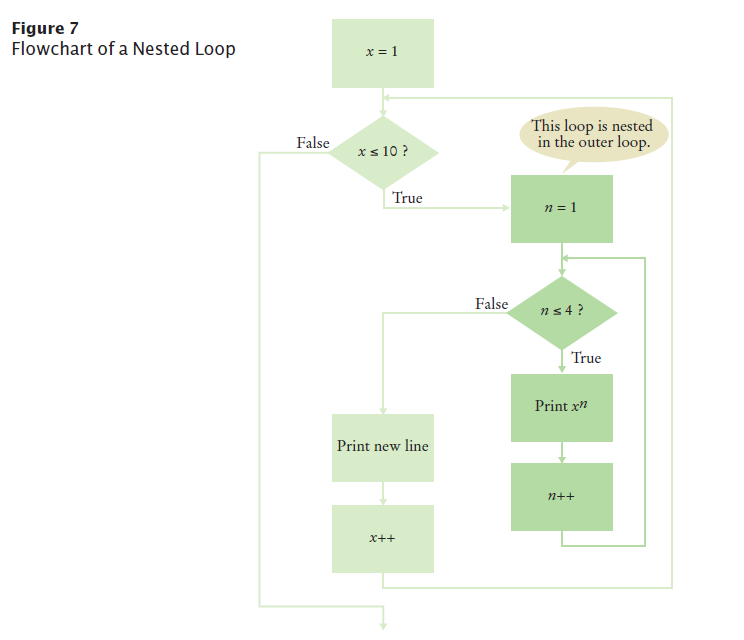
1 2 3 4
x x x x
1 1 1 1
2 4 8 16
3 9 27 81
4 16 64 256
5 25 125 625
6 36 216 1296
7 49 343 2401
8 64 512 4096
9 81 729 6561
10 100 1000 10000
for (int i = 0; i < 3; i++)
{
for (int j = 0; j < 4; j++)
{
System.out.print(i + j);
}
System.out.println();
}
for (int i = 1; i <= 3; i++)
{
for (int j = 1; j <= 4; j++)
{
System.out.print("[]");
}
System.out.println();
}

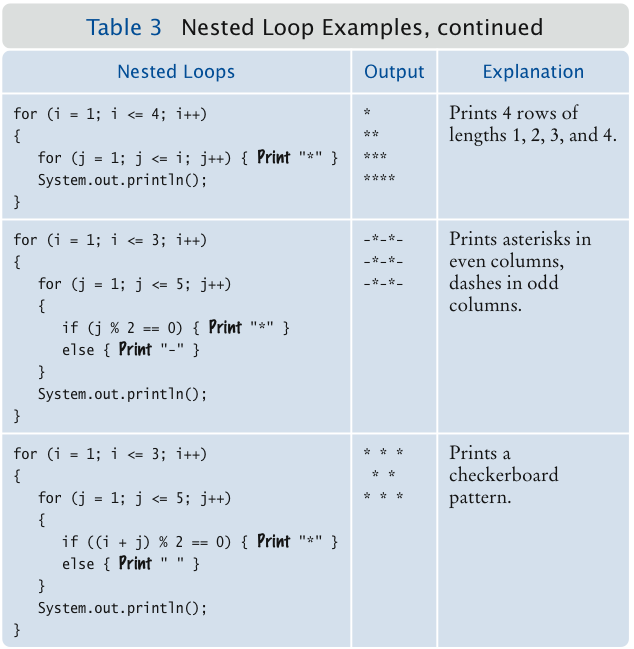
| Method | Returns |
|---|---|
| nextInt(n) | A random integer between the integers 0 (inclusive) and n (exclusive) |
| nextDouble() | A random floating-point number between 0 (inclusive) and 1 (exclusive) |
Random generator = new Random(); int d = 1 + generator.nextInt(6);
6 5 6 3 2 6 3 4 4 1
3 2 2 1 6 5 3 4 1 2
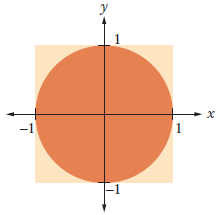
double r = generator.nextDouble(); // 0 <= r < 1 double x = -1 + 2 * r; // -1 <= x < 1
Estimate for pi: 3.1504
Die d1 = new Die(6); Die d2 = new Die(6);Then cast and print both of them:
System.out.println( d1.cast() + " " + d2.cast());
int sum = 2 + generator.nextInt(11);
int sum = generator.nextInt(6) + generator.nextInt(6) + 2;
generator.nextDouble() * 100.0

Figure 8
Stopping at a Breakpoint
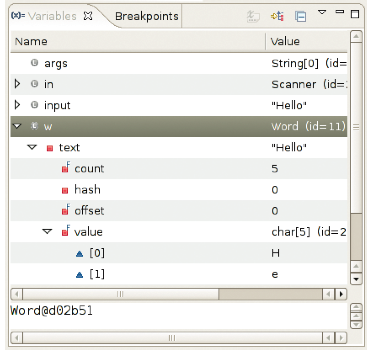
Figure 9 Inspecting Variables
String input = in.next();
Word w = new Word(input);
int syllables = w.countSyllables();
System.out.println("Syllables in " + input + ": " + syllables);
String input = in.next();
Word w = new Word(input);
int syllables = w.countSyllables();
System.out.println("Syllables in " + input + ": " + syllables);
public int countSyllables()
{
int count = 0;
int end = text.length() - 1;
. . .
}